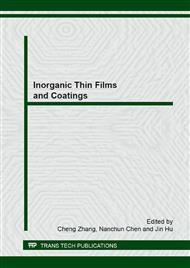p.238
p.243
p.247
p.252
p.256
p.261
p.265
p.269
p.274
Study on Special Morphology Hydroxyapatite Bioactive Coating by Electrochemical Deposition
Abstract:
Bioactive calcium phosphate coatings were deposited on carbon/carbon(C/C) composites using electrochemical deposition technique. The effects of electrolyte concentration and constant current density on morphology, structure and composition of the coating were systematically investigated using scanning electron microscopy (SEM), X-ray diffraction (XRD) and Fourier transformed infrared (FTIR) spectroscopy. The results show that, the coating weight elevated gradually with the increase of electrolyte concentration, and the morphology of coatings changed from spherical particles to nanolamellar crystals with interlocking structure initially. Then the coating transformed into seaweed-like and nano/micro-sized crystals along the depth direction of the coating. The coatings showed seaweed-like morphology as the deposition current density was less than 20mA. With the less current density, the coating became more homogenous. However, the coating was fiakiness crysal, with needlike crystal stacked upside as the current density reached to 20mA/cm2. The coating weight was improved gradually when the current density increased from 2.5mA/cm2 to 10mA/cm2, then reduced with the increasing current density in the range of 10 to 20mA/cm2.
Info:
Periodical:
Pages:
256-260
Citation:
Online since:
January 2013
Authors:
Price:
Сopyright:
© 2013 Trans Tech Publications Ltd. All Rights Reserved
Share:
Citation:


